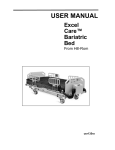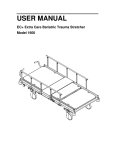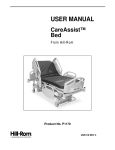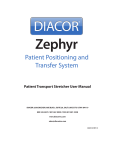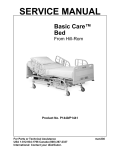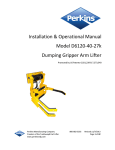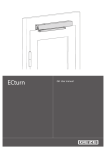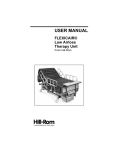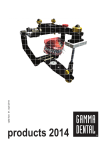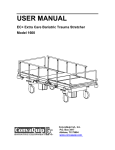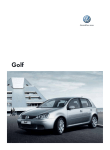Download USER MANUAL - Frank`s Hospital Workshop
Transcript
USER MANUAL Basic Care™ Bed From Hill-Rom Product No. P1440 and P1441 USR124 REV 5 1 © 2005 by Hill-Rom Services, Inc. ALL RIGHTS RESERVED. Manufactured for Hill-Rom by Optima Healthcare, Inc. Distributed by: HILL-ROM COMPANY, INC. 1069 STATE ROUTE 46E BATESVILLE, IN 47006-9617 Authorized European Union Representative: HILL-ROM EUROPE LE RABELAIS – PARIS NORD II 22 AVENUE DES NATIONS BP 50436 VILLEPINTE 95944 ROISSY CDG CEDEX FRANCE TEL: +33 (0)1 49 89 40 00 No part of this text shall be reproduced or transmitted in any form or by any means, electronic or mechanical, including photocopying, recording, or by any information or retrieval system without written permission from Hill-Rom Services, Inc. (Hill-Rom). The information in this manual is confidential and may not be disclosed to third parties without the prior written consent of Hill-Rom. Fifth Edition First Printing 2004 Printed in Taiwan Basic Care™ is a trademark of Hill-Rom Services, Inc. Comfortline® is a registered trademark of Hill-Rom Services, Inc. Hill-Rom® is a registered trademark of Hill-Rom Services, Inc. The information contained in this manual is subject to change without notice. Hill-Rom makes no commitment to update or keep current, the information contained in this manual. Hill-Rom reserves the right to make changes without notice in design, specifications, and models. The only warranty Hill-Rom makes is the express written warranty extended on the sale or rental of its products. To order additional copies of this manual (usr124), refer to the back cover for contact information. For countries not listed on the back cover, contact your distributor. NOTE: The back cover is a comprehensive list of Technical Support contact information for Hill-Rom. The product discussed in this manual may not be available in all of the countries listed. i Revision Letter Original Issue A B C 5 ii Pages Affected All All All All Date March 2004 April 2004 July 2004 July 2004 January 2005 Table of Contents Document Symbol Definition . . . . . . . . . . . . . . . . . . . . . . . . . . . . . . . . . . . . . . . . . . . 1 Intended Use . . . . . . . . . . . . . . . . . . . . . . . . . . . . . . . . . . . . . . . . . . . . . . . . . . . . . . . . 2 Introduction . . . . . . . . . . . . . . . . . . . . . . . . . . . . . . . . . . . . . . . . . . . . . . . . . . . . . . . . . 2 Features . . . . . . . . . . . . . . . . . . . . . . . . . . . . . . . . . . . . . . . . . . . . . . . . . . . . . . . . . . . . 2 Patient Characteristics . . . . . . . . . . . . . . . . . . . . . . . . . . . . . . . . . . . . . . . . . . . . . . 4 Instructions for Use . . . . . . . . . . . . . . . . . . . . . . . . . . . . . . . . . . . . . . . . . . . . . . . . . . . 5 Putting the Bed into the Emergency CPR Position . . . . . . . . . . . . . . . . . . . . . . . . 5 Putting the Electric Bed Model into the Emergency CPR Position. . . . . . . . . 5 Putting the Manual Bed Model into the Emergency CPR Position . . . . . . . . . 5 Raising and Lowering the TuckAway Siderails . . . . . . . . . . . . . . . . . . . . . . . . . . 6 Raising a Siderail . . . . . . . . . . . . . . . . . . . . . . . . . . . . . . . . . . . . . . . . . . . . . . . .6 Lowering a Siderail . . . . . . . . . . . . . . . . . . . . . . . . . . . . . . . . . . . . . . . . . . . . . 6 Storing the Siderails. . . . . . . . . . . . . . . . . . . . . . . . . . . . . . . . . . . . . . . . . . . . . 7 Using the Siderail Caregiver and Patient Controls (Electric Bed Model Only) . . 7 Raising and Lowering the Head Section . . . . . . . . . . . . . . . . . . . . . . . . . . . . . 8 Raising and Lowering the Knee Section . . . . . . . . . . . . . . . . . . . . . . . . . . . . . 8 Raising and Lowering the Head and Knee Sections Together . . . . . . . . . . . . 8 Raising and Lowering the Bed. . . . . . . . . . . . . . . . . . . . . . . . . . . . . . . . . . . . . 8 Using the Foot End Caregiver Controls (Electric Bed Model Only). . . . . . . . . . . 9 Changing the Position of the Patient or Bed . . . . . . . . . . . . . . . . . . . . . . . . . . 9 Putting the Bed into Trendelenburg or Reverse Trendelenburg . . . . . . . . . . . 9 Locking Out the Patient Controls . . . . . . . . . . . . . . . . . . . . . . . . . . . . . . . . . 10 Using the Manual Caregiver Controls (Manual Bed Model Only) . . . . . . . . . . . 11 Raising and Lowering the Head Section . . . . . . . . . . . . . . . . . . . . . . . . . . . . 12 Raising and Lowering the Bed. . . . . . . . . . . . . . . . . . . . . . . . . . . . . . . . . . . . 12 Raising and Lowering the Knee Section . . . . . . . . . . . . . . . . . . . . . . . . . . . . 12 Putting the Bed into Trendelenburg or Reverse Trendelenburg . . . . . . . . . . 12 Equipment Sockets . . . . . . . . . . . . . . . . . . . . . . . . . . . . . . . . . . . . . . . . . . . . . . . 13 Bed End Panels . . . . . . . . . . . . . . . . . . . . . . . . . . . . . . . . . . . . . . . . . . . . . . . . . . 13 Bumpers . . . . . . . . . . . . . . . . . . . . . . . . . . . . . . . . . . . . . . . . . . . . . . . . . . . . . . . . 14 Drainage Bag Holders . . . . . . . . . . . . . . . . . . . . . . . . . . . . . . . . . . . . . . . . . . . . . 14 Brake and Steer . . . . . . . . . . . . . . . . . . . . . . . . . . . . . . . . . . . . . . . . . . . . . . . . . . 14 Central Brake and Steer . . . . . . . . . . . . . . . . . . . . . . . . . . . . . . . . . . . . . . . . . 14 Caster Brake and Steer. . . . . . . . . . . . . . . . . . . . . . . . . . . . . . . . . . . . . . . . . . 14 Patient Restraint Straps . . . . . . . . . . . . . . . . . . . . . . . . . . . . . . . . . . . . . . . . . . . . 15 Battery Backup (Electric Model Only) . . . . . . . . . . . . . . . . . . . . . . . . . . . . . . . . 15 iii Disposing of the Battery . . . . . . . . . . . . . . . . . . . . . . . . . . . . . . . . . . . . . . . . .15 Mattress . . . . . . . . . . . . . . . . . . . . . . . . . . . . . . . . . . . . . . . . . . . . . . . . . . . . . . . . 16 Cleaning . . . . . . . . . . . . . . . . . . . . . . . . . . . . . . . . . . . . . . . . . . . . . . . . . . . . . . . . . . . 17 General Cleaning . . . . . . . . . . . . . . . . . . . . . . . . . . . . . . . . . . . . . . . . . . . . . . . . . 17 Steam Cleaning . . . . . . . . . . . . . . . . . . . . . . . . . . . . . . . . . . . . . . . . . . . . . . . . . . 17 Cleaning Hard to Clean Spots . . . . . . . . . . . . . . . . . . . . . . . . . . . . . . . . . . . . . . . 17 Disinfecting . . . . . . . . . . . . . . . . . . . . . . . . . . . . . . . . . . . . . . . . . . . . . . . . . . . . . 17 Maintenance. . . . . . . . . . . . . . . . . . . . . . . . . . . . . . . . . . . . . . . . . . . . . . . . . . . . . . . . .18 Safety Tips . . . . . . . . . . . . . . . . . . . . . . . . . . . . . . . . . . . . . . . . . . . . . . . . . . . . . . . . . 19 Bed Position. . . . . . . . . . . . . . . . . . . . . . . . . . . . . . . . . . . . . . . . . . . . . . . . . . . . . 19 Electrical Bed Model Only . . . . . . . . . . . . . . . . . . . . . . . . . . . . . . . . . . . . . . 19 Siderails . . . . . . . . . . . . . . . . . . . . . . . . . . . . . . . . . . . . . . . . . . . . . . . . . . . . . . . . 20 Patient Restraints . . . . . . . . . . . . . . . . . . . . . . . . . . . . . . . . . . . . . . . . . . . . . . . . . 20 Brakes . . . . . . . . . . . . . . . . . . . . . . . . . . . . . . . . . . . . . . . . . . . . . . . . . . . . . . . . . 21 Electrical Safety . . . . . . . . . . . . . . . . . . . . . . . . . . . . . . . . . . . . . . . . . . . . . . . . . . 21 Emergency CPR. . . . . . . . . . . . . . . . . . . . . . . . . . . . . . . . . . . . . . . . . . . . . . . . . . 21 Battery Backup . . . . . . . . . . . . . . . . . . . . . . . . . . . . . . . . . . . . . . . . . . . . . . . . . . 21 Mattresses . . . . . . . . . . . . . . . . . . . . . . . . . . . . . . . . . . . . . . . . . . . . . . . . . . . . . . 22 Accessories . . . . . . . . . . . . . . . . . . . . . . . . . . . . . . . . . . . . . . . . . . . . . . . . . . . . . . . . 23 Removable IV Pole (P1445A) . . . . . . . . . . . . . . . . . . . . . . . . . . . . . . . . . . . . . . . 23 Troubleshooting . . . . . . . . . . . . . . . . . . . . . . . . . . . . . . . . . . . . . . . . . . . . . . . . . . . . . 23 Bed Overheats or Shuts Down After Extensive Operation . . . . . . . . . . . . . . . . . 23 Product Symbol Definition . . . . . . . . . . . . . . . . . . . . . . . . . . . . . . . . . . . . . . . . . . . . 24 Technical Specifications . . . . . . . . . . . . . . . . . . . . . . . . . . . . . . . . . . . . . . . . . . . . . . 26 Electromagnetic Compatibility . . . . . . . . . . . . . . . . . . . . . . . . . . . . . . . . . . . . . . 29 iv Document Symbol Definition This manual contains different typefaces and icons designed to improve readability and increase understanding of its content. Note the following examples: • Standard text—used for regular information. • Boldface text—emphasizes a word or phrase. • NOTE:—sets apart special information or important instruction clarification. • The symbol below highlights a WARNING or CAUTION: Warning and Caution – A WARNING identifies situations or actions that may affect patient or user safety. Disregarding a warning could result in patient or user injury. – A CAUTION points out special procedures or precautions that personnel must follow to avoid equipment damage. • The symbol below highlights a CAUGHT HAZARD WARNING: Caught Hazard Warning • The symbol below highlights a CHEMICAL HAZARD WARNING: Chemical Hazard Warning • The symbol below highlights an ELECTRICAL SHOCK HAZARD WARNING: Electrical Shock Hazard Warning 1 Intended Use The Basic Care™ Bed is intended for use in health care environments such as a medical or surgical hospital unit or ward. Introduction This manual provides instructions for normal operation of the Basic Care™ Bed. Before operating the Basic Care™ Bed, be sure that you have read and understood in detail the contents of this manual. It is important that you read and obey the aspects of safety contained in this manual. Any reference to a side of the bed is from the patient’s view lying in the bed on their back. Features Electric model Manual model 2 Features Item A B C D E F G H I J K L M N Description Manual controls (manual model only) Electric controls (electric model only) Central brake and steer Three-caster brake and steer Four equipment sockets Clocking TuckAway siderails with zero transfer gap 12° Trendelenburg and Reverse Trendelenburg controls Trendelenburg and Reverse Trendelenburg indicators Corner bumpers Mobile 5" casters Blow-molded headboard with single-step removal and push handles Blow-molded footboard with single-step removal and push handles Emergency CPR Patient and caregiver siderail controls (electric model only) The Basic Care™ Bed also has the following features: • Head elevation gauge • Battery backup function (electric model only) • Three DC motors (electric model only) • Complete bed articulation: Hilow, head, knee, and automatic contour • Lockout controls (electric model only) • Standard color scheme from Hill-Rom The Basic Care™ Bed can be used with the following items: • Urinal devices • Sling scale devices • Foley-type bags • Hoists • Overbed tables in the low position • Basic mattresses An IV rod is available as an accessory for the Basic Care™ Bed. The Basic Care™ Bed is available in standard length or Special (short) length 3 Patient Characteristics WARNING: Do not use the product outside of the recommended patient height, weight, and width ranges. Patient injury or equipment damage could occur. Height—56" to 74" (142 cm to 188 cm) Width—36" (91 cm) Maximum patient weight—300 lb (136 kg) Safe working load—450 lb (204 kg) maximum, including patient weight, mattress, IV pumps, poles, bags, and such. 4 Instructions for Use Putting the Bed into the Emergency CPR Position Putting the Electric Bed Model into the Emergency CPR Position When activated, the CPR release disengages the head section actuator so that the head section may lower to the horizontal position. This function can be used when power is not available. The emergency CPR controls are handles located under the sleep deck, between the head end and the head end siderails on both sides of the bed. 1. Pull and hold the handle. Hold the handle until the head section come to a stop in the flat position. 2. Release the handle. NOTE: The emergency CPR control handle must be continually pulled until the head section of the bed reaches a flat position. Releasing the control handle will cause the head section to stop lowering. The head section actuator is automatically re-enabled after the CPR control handle is released. Putting the Manual Bed Model into the Emergency CPR Position At the foot end of the bed, use the manual controls to rapidly lower the head section of the bed (see “Using the Manual Caregiver Controls (Manual Bed Model Only)” on page 11). 5 Raising and Lowering the TuckAway Siderails WARNING: Evaluate patients for entrapment risk according to facility protocol, and monitor patients appropriately. WARNING: Evaluate patients for entrapment risk according to facility protocol, and monitor patients appropriately. Make sure all siderails are fully latched when in the raised position. Failure to do either of these could result in serious injury or death. NOTE: Siderails are intended to be a reminder to the patient of the unit’s edges, not a patientrestraining device. When appropriate, Hill-Rom recommends that medical personnel determine the proper methods necessary to make sure a patient remains safely in bed. WARNING: Use of a mattress overlay reduces the effective height of the siderails above the sleep surface. When using a mattress overlay, evaluate the patient for the risk of falls, and take appropriate measures. Failure to do so could result in patient injury. When the bed is occupied, the siderails should be in the raised position. Raising a Siderail 1. Pull the siderail out from under the bed. 2. Rotate the siderail up to the raised position until a click is heard. Lowering a Siderail 1. Pull the Pull siderail release lever. 2. Rotate the siderail down to the lowered position. 3. Push the siderail under the bed to the stored position. 6 Storing the Siderails The siderails may be stored completely under the frame. During patient transfer, storing the siderails under the bed frame helps eliminate the gap between the bed and the transfer vehicle. Storing the siderails also helps reduce the overall width of the bed for easier mobility. Using the Siderail Caregiver and Patient Controls (Electric Bed Model Only) WARNING: Use caution when lowering the bed frame. To avoid injury, keep extremities from under the lowering bed frame. WARNING: Before lowering the bed, look under the bed to make sure there are no people or obstructions under the bed. Failure to do so could result in serious injury or equipment damage. The Head Up/Down, Knee Up/Down, and Auto Contour patient positioning controls are located on the patient side of the head end siderails. The Hilow control is located on the caregiver side of the head end siderails to keep the patient from inadvertently starting the bed’s hilow function. Patient positioning controls Hilow control 7 Raising and Lowering the Head Section Knee Up control Head Up control Knee Down control Head Down control Raise the head section to the desired position by pressing and holding the Head Up arrow control. The head section can rise to 72.5°. Lower the head section to the desired position by pressing and holding the Head Down arrow control. Raising and Lowering the Knee Section Raise the knee section to the desired position by pressing and holding the Knee Up arrow control. The knee section can rise to 25°. Lower the knee section to the desired position by pressing and holding the Knee Down arrow control. Raising and Lowering the Head and Knee Sections Together The Automatic Contour function raises and lowers the head and knee sections to help keep the patient from sliding to the foot end of the bed. Press and hold the Auto Contour Up arrow control to raise the head and knee sections to the desired position. Press and hold the Auto Contour Down arrow control to lower the head and knee sections to the desired position. Auto Contour Up control Auto Contour Down control Raising and Lowering the Bed The Basic Care™ Bed adjusts in height from a low position, for patient entry or exit, to a high position, for examination. Use the Hilow control to lower or raise the bed to the desired height. Press and hold the Hilow Up arrow control to raise the bed to the desired position. WARNING: Use caution when lowering the bed frame. To avoid injury, keep extremities from under the lowering bed frame. Hilow Up control Hilow Down control Press and hold the Hilow Down arrow control to lower the bed to the desired position. 8 Using the Foot End Caregiver Controls (Electric Bed Model Only) The caregiver controls at the foot end of the bed include controls for the caregiver to operate the bed and lockout the patient controls. The handles for the caregiver to put the bed into the Trendelenburg or Reverse Trendelenburg position are also at the foot end of the bed. Changing the Position of the Patient or Bed WARNING: Mechanical parts under the bed pose a risk of serious injury. Exercise control over visitors, especially children, to keep people out from under the bed and prevent unauthorized access to the bed positioning controls. Failure to do so could result in patient injury, personal injury, or equipment damage. The caregiver can use the caregiver controls to operate the following functions: • Automatic contour (see “Raising and Lowering the Head and Knee Sections Together” on page 8) • Bed hilow (see “Raising and Lowering the Bed” on page 8) • Knee up and down control (see “Raising and Lowering the Knee Section” on page 8) • Head up and down control (see “Raising and Lowering the Head Section” on page 8) Putting the Bed into Trendelenburg or Reverse Trendelenburg 1. Press the Hilow Up arrow control to raise the bed to its highest position. WARNING: Before putting the bed in the Trendelenburg or Reverse Trendelenburg position, make sure the end of the bed is at least 6" (15 cm) from the wall when fully raised. Failure to do so could result in patient injury, personal injury, or equipment damage. 2. Make sure the end of the bed is at least 6" (15 cm) from the wall. WARNING: Before putting the bed in the Trendelenburg or Reverse Trendelenburg position, make sure the area under the bed is free from obstruction. Failure to do so could result in patient injury, personal injury, or equipment damage. 3. Make sure the area under the bed is free from obstruction. 9 4. Pull the Trendelenburg or Reverse Trendelenburg handle, and press the Hilow Down arrow control to lower the bed to the desired position. Reverse Trendelenburg handle Trendelenburg handle NOTE: To determine the specific degree of Trendelenburg or Reverse Trendelenburg, refer to the Trendelenburg gauges located on each side of the bed. To change the bed position from Trendelenburg or Reverse Trendelenburg, press the Hilow Up arrow control to raise the bed to its highest position. Trendelenburg gauge Locking Out the Patient Controls WARNING: Electrical component failure may cause the bed to move without any controls being operated. Locking the patient controls can significantly reduce potential for unintentional movement. If a patient’s condition is such that injury could result from unintentional movement, lock out the patient controls. Failure to do so could result in patient injury or equipment damage. Use the lockout controls on the foot end control panel to help keep the patient from operating the head, knee, or hilow functions. When necessary, use the lockout controls for patient safety. When a control is locked out, its lockout’s indicator turns on. Hilow lockout Head lockout Knee lockout 10 Using the Manual Caregiver Controls (Manual Bed Model Only) WARNING: Use caution when lowering the bed frame. To avoid injury, keep extremities from under the lowering bed frame. WARNING: Before lowering the bed frame, check under the bed to make sure there are no obstructions, children, or confused patients under the bed. Failure to do so could result in serious injury or equipment damage. The manual controls are located at the foot end of the bed. The caregiver can use the caregiver controls to change the following bed positions: • Head up and down • Bed hilow • Knee up and down The controls for putting the bed into Trendelenburg and Reverse Trendelenburg are located at the foot end of the bed. To use a caregiver control, do the following: 1. Pull the control out from the foot end of the bed. 2. Pull the crank handle out of the control. 3. Turn the crank handle to raise or lower its respective section of the bed: • To raise or lower the head section, refer to “Raising and Lowering the Head Section” on page 12. • To raise or lower the bed, refer to “Raising and Lowering the Bed” on page 12. • To raise or lower the knee section, refer to “Raising and Lowering the Knee Section” on page 12. 11 Raising and Lowering the Head Section Raise the head section to the desired position by turning the crank handle clockwise. The head section can rise to 72.5°. Lower the head section to the desired position by turning the control crank counterclockwise. Raising and Lowering the Bed The Basic Care™ Bed adjusts in height from a low position, for patient entry or exit, to a high position, for examination. Use the Hilow control to lower or raise the bed to the desired height. Raise the bed by turning the crank handle clockwise. Lower the bed by turning the crank handle counterclockwise. Raising and Lowering the Knee Section Raise the knee section to the desired position by turning the crank handle clockwise. The knee section can rise to 25°. Lower the knee section to the desired position by turning the crank handle counterclockwise. Putting the Bed into Trendelenburg or Reverse Trendelenburg 1. Raise the bed to its highest position (see “Raising and Lowering the Bed” on page 12). WARNING: Before putting the bed in the Trendelenburg or Reverse Trendelenburg position, make sure the end of the bed is at least 6" (15 cm) from the wall when fully raised. Failure to do so could result in patient injury, personal injury, or equipment damage. 2. Make sure the end of the bed is at least 6" (15 cm) from the wall. WARNING: Before putting the bed in the Trendelenburg or Reverse Trendelenburg position, make sure the area under the bed is free from obstruction. Failure to do so could result in patient injury, personal injury, or equipment damage. 3. Make sure the area under the bed is free from obstruction. 12 4. Pull the Trendelenburg or Reverse Trendelenburg lever, and lower the bed until the bed reaches the desired position (see “Raising and Lowering the Bed” on page 12). Reverse Trendelenburg handle NOTE: To determine the specific degree of Trendelenburg or Reverse Trendelenburg, refer to the Trendelenburg gauges located on each side of the bed. Trendelenburg handle To change the bed position from Trendelenburg or Reverse Trendelenburg, raise the bed to its highest position (see “Raising and Lowering the Bed” on page 12). Equipment Sockets An IV rod can be installed in any of the four equipment sockets located at the head end and foot end of the bed. Bed End Panels The Basic Care™ Bed has post-type mountings for the bed end panels. Install a bed end panel by fitting it on the two vertical mounting posts at the end of the bed. Remove a bed end panel by lifting it vertically off the mounting posts. 13 Bumpers Bumpers are located at the ends of the bed. Drainage Bag Holders Drainage bag holders are located on both sides of the bed. Brake and Steer Central Brake and Steer Foot pedals, located on both sides of the bed, operate the braking system. Press the orange brake foot pedal down on either side of the bed to lock three of the casters. Activation of the steering system locks the swivel on one caster to allow steering of the bed. To transport the patient, press the green steer pedal down on either side of the bed. Caster Brake and Steer The brake casters are located at the four corners of the bed. To set the brake, step on the lower end of the brake lever to lock the caster. To release the brake, step on the upper end of the brake lever to push it forward and unlock the caster. 14 Patient Restraint Straps WARNING: Patient restraints are not intended as substitutes for good nursing practices. Physical restraints, even correctly installed, can result in entanglement, physical injury, and death, particularly with agitated and disoriented patients. Monitor patients when using physical restraints in accordance with legal requirements and facility protocol. Installation slots for patient restraint straps are located on both sides of the sleep surface, near the siderails. For restraining devices, consult the restraint manufacturer’s instructions for use to verify the correct application of each restraining device. Slots for patient restraint straps Battery Backup (Electric Model Only) The Basic Care™ Bed has a battery backup as a standard feature. The battery lets the hilow, foot, and head motors continue operation when AC power is not available. NOTE: If the battery is completely discharged, it may take up to 5 hours to recharge. CAUTION: If the bed will not be in service for an extended period of time, have appropriate maintenance personnel remove the battery. Failure to do so could result in damage to the life of the battery or to the bed. To make sure the battery is always charged, plug the bed into an appropriate power source whenever possible. Disposing of the Battery The battery backup power comes from a lead acid battery. Hill-Rom recommends replacing the battery every two years. Dispose of the battery correctly and according to your local regulations. For assistance in disposing of the battery, contact your maintenance personnel. 15 Mattress WARNING: Mattresses that are undersized for the frame create a gap between the mattress and the siderails. The risk increases for patient entrapment or suffocation. Evaluate patients for vulnerability, and monitor patients appropriately. Failure to do so could result in patient injury or death. WARNING: Even when the surface is appropriately sized for the frame, therapy surfaces such as air mattresses, are highly conforming and may pose a risk of suffocation. If a vulnerable patient is put on a therapy surface, particularly one with a high degree of compliance along the siderails, take extra precautions to help prevent entrapment. If continuous monitoring is not feasible, consider lowering the siderails to eliminate the entrapment area. If a risk of falls from the bed exists, place a mat on the floor to absorb impact and help prevent patient injury. Failure to do so could result in patient injury. WARNING: If the patient remains in the bed when the bedding is changed, do not pull on the bedding with excessive force. Patient injury could occur. WARNING: Patients should not be allowed to smoke in bed. Sheets and pillows generally do not have flame-resistant properties. Personal injury or equipment damage could occur. The Basic Care™ Bed is compatible with the Comfortline® SE Prevention Mattress Series and any mattress that complies with the following recommended dimensions: Mattress width Mattress length—standard model Mattress length—short model Mattress thickness 16 36" to 37" (91 cm to 94 cm) 80" to 81" (203 cm to 206 cm) 76" to 77" (193 cm to 196 cm) 6" to 7" (15 cm to 18 cm) Cleaning WARNING: Follow the product manufacturer’s instructions. Failure to do so could result in personal injury or equipment damage. SHOCK HAZARD: The potential for electrical shock exists with electrical equipment. Failure to follow facility protocols may result in death or serious personal injury. SHOCK HAZARD: Unplug the unit from its power source. Failure to do so could result in personal injury or equipment damage. SHOCK HAZARD: Do not expose the unit to excessive moisture. Personal injury or equipment damage could occur. CAUTION: Do not use harsh cleansers, solvents, or detergents. Equipment damage could occur. General Cleaning We recommend that you clean the unit with detergent and warm water. Do not use excessive liquid or harsh cleansers. Steam Cleaning Do not use any steam cleaning device on the unit. Excessive moisture can damage mechanisms in this unit. Cleaning Hard to Clean Spots To remove difficult spots or stains, we recommend that you use standard household cleansers and a soft bristle brush. To loosen heavy, dried-on soil, you may first need to saturate the spot. Disinfecting When there is visible soilage and also between patient use, we recommend that you disinfect the unit using an EPA registered (US only), tuberculocidal, disinfectant. Dilute and use the disinfectant as specified on the manufacturer's label. 17 Maintenance WARNING: Only facility-authorized personnel should service the Basic Care™ Bed. Servicing by unauthorized personnel could result in personal injury or equipment damage. Perform annual preventive maintenance to make sure all bed features function correctly. Pay particular attention to safety features, including but not limited to the following: • Siderail latching mechanisms • Caster braking systems • Electrical cords and components • Control function operation • Lockout function operation • Battery backup • CPR release 18 Safety Tips Bed Position WARNING: It is recommended that the unit be in the low position when the patient is unattended. This may reduce the severity of any resultant injuries from patient falls. WARNING: When a patient’s condition (such as disorientation due to medication or clinical condition) could lead to patient entrapment, the sleep deck should be left in the flat and lowest position while unattended (except when required otherwise by medical staff for special or particular circumstances). Failure to do so could result in patient injury or death. WARNING: Before putting the bed in the Trendelenburg or Reverse Trendelenburg position, make sure the end of the bed is at least 6" (15 cm) from the wall when fully raised. Failure to do so could result in patient injury, personal injury, or equipment damage. WARNING: Before putting the bed in the Trendelenburg or Reverse Trendelenburg position, make sure the area under the bed is free from obstruction. Failure to do so could result in patient injury, personal injury, or equipment damage. WARNING: Use caution when lowering the bed frame. To avoid injury, keep extremities from under the lowering bed frame. WARNING: Before lowering the bed, look under the bed to make sure there are no people or obstructions under the bed. Failure to do so could result in serious injury or equipment damage. When changing bed positions, make sure hands, feet, and equipment are well clear of the frame assemblies. Electrical Bed Model Only WARNING: Mechanical parts under the bed pose a risk of serious injury. Exercise control over visitors, especially children, to keep people out from under the bed and prevent unauthorized access to the bed positioning controls. Failure to do so could result in patient injury, personal injury, or equipment damage. 19 WARNING: Electrical component failure may cause the bed to move without any controls being operated. Using the lockout system can significantly reduce potential for unintentional movement. If a patient’s condition is such that injury could result from unintentional movement, use the lockout system. Failure to do so could result in patient injury or equipment damage. Siderails WARNING: Evaluate patients for entrapment risk according to facility protocol, and monitor patients appropriately. WARNING: Evaluate patients for entrapment risk according to facility protocol, and monitor patients appropriately. Ensure that all siderails are fully latched when in the raised position. Failure to do either of these could result in serious injury or death. NOTE: Siderails are intended to be a reminder to the patient of the unit’s edges, not a patientrestraining device. When appropriate, Hill-Rom recommends that medical personnel determine the proper methods necessary to ensure a patient remains safely in bed. WARNING: Use of a mattress overlay reduces the effective height of the siderails above the sleep surface. When using a mattress overlay, evaluate the patient for the risk of falls, and take appropriate measures. Failure to do so could result in patient injury. To make sure the siderails are latched, give the siderails a gentle tug in a downward direction. Patient Restraints WARNING: Patient restraints are not intended as substitutes for good nursing practices. Physical restraints, even correctly installed, can result in entanglement, physical injury, and death, particularly with agitated and disoriented patients. Monitor patients when using physical restraints in accordance with legal requirements and facility protocol. 1. Develop guidelines for all patients that show: • Which patients may need to be restrained and the appropriate restraint to use. • The correct method to monitor a patient, whether restrained or not, including time interval, visual check of restraint, and such. 2. Develop training programs for all caregivers concerning the correct use and application of restraints. 3. Maintain the bed at its lowest position whenever a caregiver is not in the room. 4. Clarify the need for restraint devices to families or guardians. 20 For restraining devices, consult the restraint manufacturer’s instructions for use to verify the correct application of each restraining device. Brakes WARNING: Unless transporting the patient, always set the brakes when the unit is occupied. Reconfirm that the brakes are set before any patient transfer. Failure to do so may result in personal injury or equipment damage. Patients often use the bed for support when getting off the bed and could be injured if the bed unexpectedly moves. After setting the brakes, push and pull the bed siderails to make sure it is secure. Electrical Safety CAUGHT HAZARD: The risks associated with the use of electrical beds exceed the obvious electrical shock hazards. Whenever a bed is being serviced, unplug it from its power source, and disconnect the battery backup. Failure to do so could result in personal injury or equipment damage. SHOCK HAZARD: The potential for electrical shock exists with electrical equipment. Failure to follow facility protocols may result in death or serious personal injury. WARNING: Improper use or handling of the power cord may result in damage to the power cord. If damage has occurred to the power cord, immediately remove the bed from service, and contact the appropriate maintenance personnel. Failure to do so could result in personal injury or equipment damage. When the integrity of the external protective earth conductor is in doubt, operate the bed from its internal battery backup. Emergency CPR The emergency CPR is to be used by healthcare professionals only. Battery Backup CAUTION: If the bed will not be in service for an extended period of time, have appropriate maintenance personnel remove the battery. Failure to do so could result in damage to the life of the battery or to the bed. The battery backup power comes from a lead acid battery, which needs to be disposed of correctly and according to your local regulations. For assistance in disposing of the battery, contact your maintenance technician. 21 Mattresses WARNING: Mattresses that are undersized for the frame create a gap between the mattress and the siderails. The risk increases for patient entrapment or suffocation. Evaluate patients for vulnerability, and monitor patients appropriately. Failure to do so could result in patient injury or death. WARNING: Even when the surface is appropriately sized for the frame, therapy surfaces such as air mattresses, are highly conforming and may pose a risk of suffocation. If a vulnerable patient is put on a therapy surface, particularly one with a high degree of compliance along the siderails, take extra precautions to help prevent entrapment. If continuous monitoring is not feasible, consider lowering the siderails to eliminate the entrapment area. If a risk of falls from the bed exists, place a mat on the floor to absorb impact and help prevent patient injury. Failure to do so could result in patient injury. WARNING: If the patient remains in the bed when the bedding is changed, do not pull on the bedding with excessive force. Patient injury could occur. WARNING: Patients should not be allowed to smoke in bed. Sheets and pillows generally do not have flame-resistant properties. Personal injury or equipment damage could occur. Unless the facility takes certain precautions, the area between the mattress and the siderails may create a gap in which highly vulnerable patients may become entrapped and suffocate: • Mattresses that are undersized for the frame may create a gap and increase the risk. • Evaluate patients for vulnerability, and monitor patients appropriately. 22 Accessories Accessories Part Number P1445A Description Removable IV pole Removable IV Pole (P1445A) WARNING: Do not exceed the load capacity of the removable IV pole. If the removable IV pole is overloaded, personal injury or equipment damage could occur. WARNING: Failure to properly secure the removable IV pole could allow it to fall, resulting in personal injury or equipment damage. WARNING: Uneven loading of the removable IV pole could allow the contents to fall, resulting in personal injury or equipment damage. The IV pole is a removable telescopic pole that installs in any of the four equipment sockets on the bed. Troubleshooting Bed Overheats or Shuts Down After Extensive Operation The Basic Care™ Bed protects itself from overheating. To help make sure overheating does not occur, do the following during clinical tasks: • Do not run the motors more than necessary. • Do not run more than two functions at once. If the bed shuts down after extensive operation, do the following: 1. Unplug the bed from its power source. 2. Allow 20 minutes for the bed to cool. 3. Plug the bed into an appropriate power source. 4. If the problem still exists, call Hill-Rom Technical Support for assistance. 23 Product Symbol Definition The following symbols are used on the Basic Care™ Bed: Symbol Description Type B equipment according to EN 60601-1. IPX4 According to IEC 60529, rating for protection against fluid ingress and identified as equipment that is protected against unpressurized spraying and splashing water. CAUTION: Consult accompanying documents. Conforms to the European Medical Device Directive 93/42/EEC Medical Electrical Equipment Classified By Underwriters Laboratories Inc. with respect to Electric Shock, Fire, and Mechanical Hazards only in accordance with UL 60601-1, CAN/CSA C22.2 No. 601.1, IEC 60601-1, IEC 60601-2-38, and IEC 60601-1-2. a Do Not Use with Oxygen Tents—shows that oxygen tents are not to be used. Use oxygen administering equipment of the nasal, mask, or ventilator type only. Alternating current ~ Safe Working Load—450 lb (204 kg) maximum, including patient weight, mattress, IV pumps, poles, bags, and such. a. The UL logo is a registered trademark of Underwriter’s Laboratories, Inc. 24 Symbol Description Duty cycle 3 min. ON/ 17 min. OFF Equipotential Approved by Dansk Elektroteknisk Komite (DEMKO) Fuse F Lead acid battery PbS Dangerous voltage Recycle in accordance with local regulations Protective earth (ground) Indicates handle for lowering the backrest in an emergency to do cardiopulmonary resuscitation (CPR) 25 Technical Specifications Product Identification Product Number P1440 P1441 Description Basic Care™ Bed—electric model Basic Care™ Bed—manual model Dimensions for Basic Care™ Bed Feature Length—with standard sleep deck Length—with short sleep deck Sleep deck length—standard model Sleep deck length—short model Maximum width—with siderails raised Dimension 89" to 91" (226 cm to 231 cm) 86" to 88" (218 cm to 224 cm) 79" to 81" (201 cm to 206 cm) 75" to 77" (191 cm to 196 cm) 43.7" (110.9 cm) Minimum width—with siderail stored 36.6" (93.0 cm) Sleep deck width 36.25" (92.08 cm) Maximum headboard height 44" (112 cm) Minimum underbed clearance 5.5" (13.9 cm) Wheel base 61" (155 cm) Caster size 5" (13 cm) Total weight 310 lb (141 kg) Recommended dimensions for the mattress: Mattress width (minimum) 36" (91 cm) Mattress width (maximum) 37" (94 cm) Mattress length—standard model (mini- 80" (203 cm) mum) Mattress length—standard model (maxi- 81" (206 cm) mum) Mattress length—short model (minimum) 76" (193 cm) Mattress length—short model (maximum) 77" (196 cm) Mattress thickness (minimum) 6" (15 cm) Mattress thickness (maximum) 7" (18 cm) 26 Specifications for Basic Care™ Bed Feature Dimension Head section inclination (maximum) Knee section inclination (maximum) Sleep deck height range Trendelenburg position (maximum) Reverse Trendelenburg position (maximum) Bed lift capacity (maximum safe working load) Foot section lift capacity (maximum) Head section lift capacity (maximum) Maximum height of seat section (in Trendelenburg position) Siderail opening size Distance between siderails 72.5° 25° 18.3" to 30.1" (46.5 cm to 76.5 cm) 12° 12° 450 lb (204 kg) 200 lb (91 kg) 200 lb (91 kg) 23.5" (59.7 cm) 3.875" (9.843 cm) 11.375" (28.893 cm) Environmental Conditions for Transport and Storage Condition Temperature Relative humidity (RH) Pressure Range -40°F to 158°F (-40°C to 70°C) 10% to 95% 500 hPa to 1060 hPa Environmental Conditions for Use Condition Temperature Relative humidity (RH) Atmospheric pressure Range 50°F to 104°F (10°C to 40°C) ambient temperature 30% to 95%, non-condensing 700 hPa to 1060 hPa Mains Power Requirements Condition Rated voltage Power/Input Frequency Range 100 V, 110 V to 115 V, 120 V to 127 V, 220 V to 230 V, 240 V 100V to 127 V—1.2 A 220 V to 240 V—0.6 A 50/60 Hz 27 Battery Specifications Condition Range Maximum battery life, with no functions 24 hours operated and the bed unplugged from its power source Time necessary to recharge a fully 8 hours discharged battery Maximum hilow cycles with fully charged battery: With 0 lb (0 kg) on bed 21 With 250 lb (113 kg) on bed 15 With 450 lb (204 kg) on bed 11 Classification and Standards The Basic Care™ Bed is designed and manufactured according to the following equipment classifications and standards: Technical and Quality Assurance UL 60601-1 Standards CSA® C22.2 No. 601.1 EN 60601-2-38, including amendment 1 EN 60601-1 IEC 60601-1-2 EN ISO 9002 Equipment classification per EN 60601-1 Class I equipment, internally powered equipment Degree of protection against electric Type B shock per EN 60601-1 Classification according to Directive Class I 93/42/EEC Degree of protection against the presence Not for use with flammable anaesthetics. of flammable anaesthetic mixtures IPX classification IPX4—According to IEC 60529, rating for protection against fluid ingress and identified as equipment that is protected against unpressurized spraying and splashing water. a a. CSA® is a registered trademark of Canadian Standards Association, Inc. 28 Electromagnetic Compatibility Medical electrical equipment needs special precautions regarding electromagnetic compatibility (EMC) and needs to be installed and put into service according to the EMC information provided in this user manual. Portable and mobile radio frequency (RF) communications equipment can affect medical electrical equipment. Electromagnetic Emissions Guidance Guidance and Manufacturer's Declaration—Electromagnetic Emissions The Basic Care™ Bed is intended for use in the electromagnetic environment specified below. The customer or the user of the bed should make sure it is used in such an environment. Emissions Test Compliance Electromagnetic Environment—Guidance RF Emissions CISPR 11 Group 1 The Basic Care™ Bed uses RF energy only for its internal functions. Therefore, its RF emissions are low and are not likely to cause any interference in nearby electronic equipment. RF Emissions CISPR 11 Class A Harmonic Emissions IEC 61000-3-2 Not applicable The Basic Care™ Bed is suitable for use in all establishments other than domestic and those directly connected to the public low-voltage power supply network that supplies buildings used for domestic purposes. Voltage Fluctuations/ Flicker Emissions IEC 61000-3-3 Not applicable 29 Electromagnetic Immunity Guidance Guidance and Manufacturer's Declaration - Electromagnetic Immunity The Basic Care™ Bed is intended for use in the electromagnetic environment specified below. The customer or the user of the bed should make sure it is used in such an environment. Immunity Test IEC 60601 Test Level Compliance Level Electromagnetic Environment—Guidance Electrostatic Discharge (ESD) IEC 610004-2 ± 6 kV Contact ± 8 kV Air ± 6 kV Contact ± 8 kV Air Floors should be wood, concrete, or ceramic tile. If floors are covered with synthetic material, the relative humidity should be at least 30%. Radiated RF IEC 610004-3 3 Vrms 80 MHz to 2.5 GHz 3 Vrms 80 MHz to 2.5 GHz Portable and mobile RF communications equipment should not be used at close distances to the Basic Care™ Bed. (See Note 2) Electrical Fast Transient/Burst IEC 610004-4 ± 2 kV on Power Supply Lines ± 1 kV on Input/ Output Lines ± 2 kV on Power Supply Lines ± 1 kV on Input/ Output Lines Mains power quality should be that of a typical commercial or hospital environment Surge IEC 610004-5 ± 1 kV Differential Mode ± 2 kV Common Mode ± 1 kV Differential Mode ± 2 kV Common Mode Mains power quality should be that of a typical commercial or hospital environment Conducted RF IEC 610004-6 3 Vrms 150 kHz to 80 MHz 10 Vrms from 80 MHz to 2.5 GHz 3 Vrms 150 kHz to 80 MHz 10 Vrms from 80 MHz to 2.5 GHz Portable and mobile RF communications equipment (cell phones) should not be used at close distances to the Basic Care™ Bed. (See Note 2) Power Frequency Magnetic Fields IEC 610004-8 3 A/m 3 A/m Power frequency magnetic fields should be at levels characteristic of a typical location in a typical commercial or hospital environment. 30 Guidance and Manufacturer's Declaration - Electromagnetic Immunity The Basic Care™ Bed is intended for use in the electromagnetic environment specified below. The customer or the user of the bed should make sure it is used in such an environment. Immunity Test IEC 60601 Test Level Compliance Level Electromagnetic Environment—Guidance Voltage Dips, Short Interrupts, & Variations On Power Supply Lines IEC 610004-11 < 5% UT (95% dip in UT for 0.5 cycles) < 40% UT (60% dip in UT for 5 cycles) < 70% UT (30% dip in UT for 25 cycles) < 5% UT (95% dip in UT for 5 seconds) (See note 1.) < 5% UT (95% dip in UT for 0.5 cycles) < 40% UT (60% dip in UT for 5 cycles) < 70% UT (30% dip in UT for 25 cycles) < 5% UT (95% dip in UT for 5 seconds) Mains power quality should be that of a typical commercial or hospital environment. If operation is required during an extended power outage or interruption, the Basic Care™ Bed should be switched to operate from the backup battery. Note 1: UT is the AC mains voltage prior to application of the test level. Note 2: The compliance levels in the ISM frequency range 150 kHz to 2.5 GHz are intended to decrease the likelihood that mobile or portable communications equipment could cause interference if it is inadvertently brought into the patient area. However, Emission limits, IEC 60601 Test Levels, and tests specified in IEC 60601-1-2:2001 do not address Electromagnetic Compatibility of electrical equipment at very close distances. Care should always be exercised when using any electrical or RF equipment in the immediate patient area. 31 32 0 Batesville USA Hill-Rom Company, Inc. 1069 State Route 46 E Batesville, IN 47006-9167 Tech. Support: 800-445-3720 www.hill-rom.com USA Rental Therapy Hill-Rom Company, Inc. 4349 Corporate Road Charleston, SC 29405 Tel: 800-638-2546 St. Paul, MN USA Hill-Rom Company, Inc. 1020 W. County Road F St. Paul, MN 55126 Tel: 651-490-1468 or 800-426-4224 www.thevest.com Belgique / België Distribal Admiral De Boisot Straat 19-21 2000 Antwerpen Tel: +32 (0)32 38 43 15 Fax: +32 (0)32 16 06 86 Canada Hill-Rom Canada 5444 Timberlea Blvd. Mississauga, Ontario Canada L4W 2T7 Tel: 800-267-2337 Deutschland Hill-Rom GmbH Franz-Rennefeld-Weg 4 40472 Dusseldorf Tel: +49 (0)211 16450 0 Fax: +49 (0)211 16450 182 Ellás Meditime Nikolaos Chatziioannidis Egnatia 142 Str 54622 Thessaloniki Tel: +30 2310 263300 Fax: +30 2311 263329 España Hill-Rom Iberia S.L. C/ Comerc, n° 2-22, Nave n° 14 Poligno Industrial EL PLA 08980 Sant Feliu de Llobregat (Barcelona) - SPAIN Tel: +34 (0)93 685 6009 Fax: +34 (0)93 666 5570 France Hill-Rom SAS Z.I. du Talhouët, BP 14 56330 Pluvigner Tel: +33 (0)2 97 50 92 12 Service France: +33 (0)820 01 23 45 Fax: +33 (0)2 97 50 92 00 Ireland Hill-Rom Ltd. Unit 1 - Kilcarberry Business Park Nangor Road Dublin 22 Tel: +353 (0)1 413 6005 Fax: +353 (0)1 413 6030 [email protected] Italia Hill-Rom S.p.A. Via Ambrosoli 6 20090 Rodano Tel: +39 (0)02 / 950541 Fax: +39 (0)02 / 95328578 Nederland Hill-Rom Medical Services BV Hagenweg 1c Postbus 173 4130 ED Vianen Tel: +31 (0)347 / 32 35 32 Fax: +31 (0)347 / 32 35 00 Nordic Region Hill-Rom AB Ekbacksvägen 20 168 69, Bromma Sweden Tel: +46 (0)8 564 353 60 Fax: +46 (0)8 564 353 61 [email protected] Österreich Hill-Rom Austria GmbH Bueropark Donau / Haus 8 3400 Klosterneuburg Tel: +43 (0)2243 / 28550 Fax: +43 (0)2243 / 28550-19 [email protected] Portugal Hill-Rom Iberia S.L. C/ Comerc, n° 2-22, Nave n° 14 Poligno Industrial EL PLA 08980 Sant Feliu de Llobregat (Barcelona) - SPAIN Tel: +34 (0)93 685 6009 Fax: +34 (0)93 666 5570 Suisse / Schweiz Hill-Rom SA Chemin du Vallon 26 1030 Bussigny Tel: +41 (0)21 / 706 21 30 Fax: +41 (0)21 / 706 21 33 hrch.info@hill-rom United Kingdom Hill-Rom Ltd. Clinitron House Ashby Park Ashby de la Zouch Leicestershire LE65 1JG Tel: +44 (0)1530 411000 Fax: +44 (0)1530 411555 International Hill-Rom Company, Inc. International Department 1069 State Route 46 East, J55 Batesville, Indiana 47006 USA Tel: +1 (0)812 934 8173 Fax: +1 (0)812 934 7191 www.hill-rom.com [email protected]








































